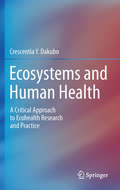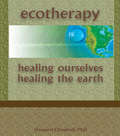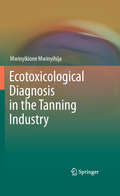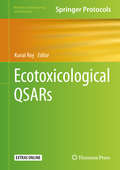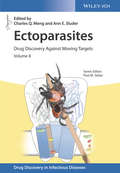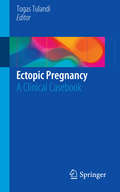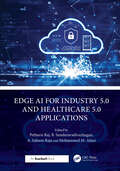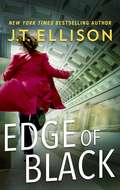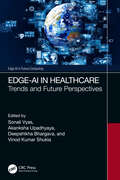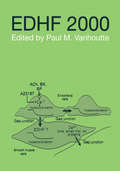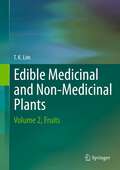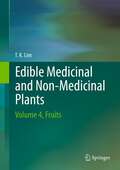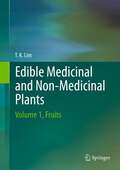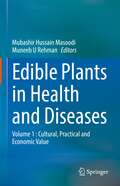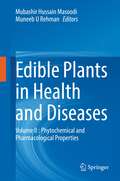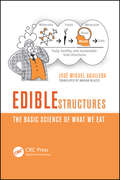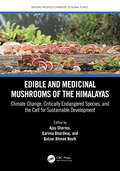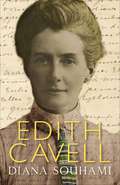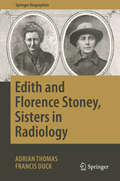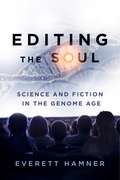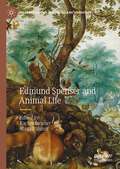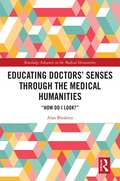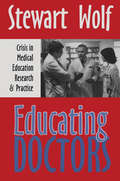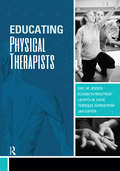- Table View
- List View
Ecosystems and Human Health
by Crescentia Y. DakuboEcosystems and Human Health introduces Ecohealth as an emerging field of study, traces its evolution, and explains its applications in cross-disciplinary and holistic programs. Its integrative approach not only focuses on managing the environment to improve health, but also analyzes underlying social and economic determinants of health to develop innovative, people-centered interventions.
Ecotherapy: Healing Ourselves, Healing the Earth
by Howard ClinebellHere is a trailblazing book on issues of vital interest to the future of humankind. Ecotherapy: Healing Ourselves, Healing the Earth sheds light on humankind’s most serious health challenge ever--how to save our precious planet as a clean, viable habitat. As a guide for therapists, health professionals, pastoral counselors, teachers, medical healers, and especially parents, Ecotherapy: Healing Ourselves, Healing the Earth highlights readers’strategic opportunities to help our endangered human species cope constructively with the unprecedented challenge of saving a healthful planet for future generations.Ecotherapy: Healing Ourselves, Healing the Earth introduces readers to an innovative approach to ecologically-grounded personality theory, spirituality, ecotherapy, and education. The book shares the author’s well-developed theories and methods of ecological diagnosis, treatment, and education so professionals and parents, our most influential teachers, can rise to the challenge of saving our planet. Readers will find that the book helps them accomplish this goal as it: explores an expanded, ecologically grounded theory of personality development, the missing dimension in understanding human identity formation outlines a model for doing ecologically oriented psychotherapy, counseling, medical healing, teaching, and parenting describes life-saving perspectives for making one’s lifestyle more earth-caring demonstrates the importance of hope, humor, and love suggests how these earthy approaches may be utilized in a variety of social contexts and cultures A systematic theory and practice guidebook, Ecotherapy: Healing Ourselves, Healing the Earth fills a wide gap in both the counseling and therapy literature and the ecology literature. It offers an innovative model for fulfilling the “ecological circle” between humans and nature with three action dimensions. These are self-care by being intentionally nurtured by nature; spiritual enrichment by enjoying the transcendent Spirit in nature; and responding by nurturing nature more responsibly and lovingly.The theories and practical applications presented in the book come together to explore long-overlooked issues at the boundary between human health and the health of the natural environment. Psychotherapists, health professionals, and teachers; pastoral counselors and other clergy who counsel and teach; laypersons who are parents and grandparents; and individuals and groups interested in environmental issues will find Ecotherapy: Healing Ourselves, Healing the Earth essential for approaching the long-neglected earthy roots of the total human mind-body-spirit organism.
Ecotoxicological Diagnosis in the Tanning Industry
by Mwinyikione MwinyihijaThe primary focus in this book is to identify the ecotoxicological impacts related to the tanning industry on terrestrial and aquatic systems. The research incorporated both field related and laboratory based techniques in the experimental design to address the underlying environmental problems in the tanning sector. First, the study aimed to investigate the occupational hazards within a tannery caused by contaminated dust. An optical set-up involving microscopy and digital imaging techniques was initially used to determine dust particle numbers and size distributions. After determining the particulate numbers and sizes a Monte Carlo method was used to estimate the concentration of the dust in the air throughout the tannery during an 8 h working day. However knowing the particulate quantitative profile is always not sufficient to adjudge the toxic potency of the dust. In retrospect therefore the work related to the book inclined a notch higher to determine the toxic nature of the dust (in addition to particle size relation to toxicity). Therefore an ecotoxicological screening of the dust samples for the first time (using a solid and liquid assay involving the response of luminescence (lux)-based bacterial biosensor) was conducted and complemented by chemical analysis to identify possible causative toxic components. In the second phase of the study, the tannery effluent and associated environmental samples were dissected and manipulated through sparging, treatment with activated charcoal, filtration and pH adjustment. The approach used highlighted the complexiity of toxic pollutants in the effluent from the tanning industry and the potential for remediation. Third, with the tannery effluent discharged into the adjacent river system (used for domestic and agricultural purposes) a partial environmental impact study (integrating toxicity assessment, measurement of microbial biomass activity and chemical analysis) was conducted with the main objective of investigating the river health status. Finally, three specific objectives were also achieved at the end of the investigation: characterization of effluents and sediments and riverine samples, assessment of ecotoxicity and bioremediation potential of primary contaminants and input of environmental risk assessment through development of a quantitative and qualitative risk assessment model also for the first time reported for the tanning industry. This initiative was primarily for the grand purpose of establishing the ecotoxicological impact of the tanning industry using the most current developed bioassays.
Ecotoxicological QSARs (Methods in Pharmacology and Toxicology)
by Kunal RoyThis volume focuses on computational modeling of the ecotoxicity of chemicals and presents applications of quantitative structure–activity relationship models (QSARs) in the predictive toxicology field in a regulatory context. The extensive book covers a variety of protocols for descriptor computation, data curation, feature selection, learning algorithms, validation of models, applicability domain assessment, confidence estimation for predictions, and much more, as well as case studies and literature reviews on a number of hot topics. Written for the Methods in Pharmacology and Toxicology series, chapters include the kind of practical advice that is essential for researchers everywhere. Authoritative and comprehensive, Ecotoxicological QSARs is an ideal source to update readers in the field with current practices and introduce to them new developments and should therefore be very useful for researchers in academia, industries, and regulatory bodies.
Ectoparasites: Drug Discovery Against Moving Targets (Drug Discovery in Infectious Diseases #Volume 8)
by Paul M. Selzer Charles Q. Meng Ann E. SluderThis first book specifically dedicated to ectoparasite drug discovery is unique in providing insights from the veterinary as well as the medical perspective, covering research from both industry and academia while paving the way for new synergies between the two research communities. <p><p> Edited by a team combining 80 years of experience in academic research and industrial antiparasitic drug discovery, this volume of Drug Discovery in Infectious Diseases summarizes current knowledge in this rapidly expanding field. Comprehensive yet concise, this ready reference blends solid background information on ectoparasite biology with the very latest methods in ectoparasite drug discovery. Three major parts cover current ectoparasite control strategies and the threat of drug resistance, screening and drug evaluation, and the new isoxazoline class of ectoparasiticides. The future potential of mechanism-based approaches for repellents and parasiticides is thoroughly discussed, as are strategies for vaccines against ectoparasites, making the book ideal for parasitologists in academia as well as researchers working in the pharmaceutical industry.
Ectopic Pregnancy
by Togas TulandiComprised exclusively of clinical cases covering ectopic pregnancy, this concise, practical casebook will provide clinicians in reproductive medicine and obstetrics/gynecology with the best real-world strategies to properly diagnose and treat the various forms of the condition they may encounter. Each chapter is a case that opens with a unique clinical presentation, followed by a description of the diagnosis, assessment and management techniques used to treat it, as well as the case outcome and clinical pearls and pitfalls. Cases included illustrate different management strategies - from treatment with methotrexate to surgical interventions - as well as types of ectopic pregnancy, such as ovarian, interstitial, heterotopic and abdominal forms, among others. Pragmatic and reader-friendly, Ectopic Pregnancy: A Clinical Casebook will be an excellent resource for reproductive medicine specialists, obstetricians and gynecologists, and family and emergency medicine physicians alike.
Edge AI for Industry 5.0 and Healthcare 5.0 Applications
by Pethuru Raj Mohammed M. Alani B. Sundaravadivazhagan A. Saleem RajaEdge AI is the seamless and spontaneous combination of Edge or Fog computing and AI. It enables acquiring real-time insights, which, in turn, leads to the realization of real-time, people-centric, event-driven, business-critical, process-aware, and knowledge-filled software services and applications.Edge AI for Industry 5.0 and Healthcare 5.0 Applications looks at the unique contributions of Edge AI for developing solutions for Industry 5.0 and Healthcare 5.0. It explains how Industry 5.0 fine tunes the human-machine connection and leverages tiny, high-performance AI-centric processors in IoT edge devices for real-time decision-making and application processing.Focusing on Explainable AI (XAI), the book discusses:· The role of XAI in Healthcare 5.0· Best practices, challenges, and opportunities of applying XAI in healthcare setting· How to enhance transparency and trust of XAI in Healthcare 5.0· XAI and its methods in predicting healthcare outcomesOther highlights of the book include:· 5G communication networks requirements· The fusion of IoT, AI, Edge, Cloud, and blockchain· Trustworthiness of blockchain technology in healthcare 5.0 and Industry 5.0· The future of trust and the potential of blockchain technologyBy explaining how Edge AI can transform healthcare and industry, this book empowers researchers and professionals to envisage and implement sophisticated and smart digital solutions.
Edge of Black: A Deeper Darkness Edge Of Black (A Samantha Owens Novel #2)
by J. T. EllisonRevisit the thrilling Sam Owens series, with book two in the series from New York Times bestselling author J.T. Ellison.Dr. Samantha Owens is starting over: new city, new job, new man, new life. But before she’s even unpacked her office at Georgetown University’s forensic pathology department, she’s called to consult on a case that’s rocked the capital and the country. An unknown pathogen released into the Washington Metro has caused nationwide panic. Three people died—just three.Amid the media frenzy and Homeland Security alarm bells, Sam painstakingly dissects the lives of those three victims and makes an unsettling conclusion. This is no textbook terrorist, but an assassin whose motive is deeply personal and far from understandable.Xander Whitfield, a former army ranger and Sam’s new boyfriend, knows about seeing the world in shades of gray. About feeling compelled to do the wrong thing for the right reasons. Only his disturbing kinship with a killer can lead Sam to the truth…and once more into the line of fire.Originally published in 2012“Shocking suspense, compelling characters and fascinating forensic details.” —Lisa Gardner, # 1 New York Times bestselling author“A terrific thriller…fans of forensic mysteries, such as those by Patricia Cornwell, should immediately add this series to their A-lists.” —Booklist
Edge-AI in Healthcare: Trends and Future Perspectives (Edge AI in Future Computing)
by Sonali Vyas, Akanksha Upadhyaya, Deepshikha Bhargava, and Vinod Kumar ShuklaThe book provides comprehensive research ideas about Edge-AI technology that can assist doctors in making better data-driven decisions. It provides insights for improving the healthcare industry by examining future trends, simplifying decision making and investigating structured and unstructured data.Edge-AI in Healthcare: Trends and Future Perspective is more than a comprehensive introduction to Artificial Intelligence as a tool in healthcare data. The book is split into five chapters covering the entire healthcare ecosystem. First section is introduction to Edge-AI in healthcare. It discusses data usage, modelling and simulation techniques as well as machine and deep learning approaches. The second section discusses the implementation of edge AI for smart healthcare. The topics discussed in this section include, AR/VR and cloud computing, big data management, algorithms, optimization, and IoMT techniques and methods. Third section covers role of Edge-AI in healthcare and the challenges and opportunities of the technologies. This section also provides case studies and discusses sustainability, security, privacy, and trust related to Edge-AI in healthcare. This book is intended to benefit researchers, academics, industry professionals, R & D organizations and students working in the field of healthcare, healthcare informatics and their applications.
Edhf 2000
by Paul M. VanhoutteUnderstanding the nature and role of endothelium-derived hyperpolarizing factor appears to be crucial in the quest for improved treatments for hypertension, diabetes, ischemia-reperfusion and other vascular disorders.EDHF 2000 comprises the proceedings of the Third International Symposium on endothelium-dependent hyperpolarizations. The first t
Edible Medicinal And Non Medicinal Plants
by Lim T. K.This book continues as volume 3 of a multi-compendium on Edible Medicinal and Non-Medicinal Plants. It covers edible fruits/seeds used fresh or processed, as vegetables, spices, stimulants, edible oils and beverages. It encompasses species from the following families: Ginkgoaceae, Gnetaceae, Juglandaceae, Lauraceae, Lecythidaceae, Magnoliaceae, Malpighiaceae, Malvaceae, Marantaceae, Meliaceae, Moraceae, Moringaceae, Muntigiaceae, Musaceae, Myristicaceae and Myrtaceae. This work will be of significant interest to scientists, researchers, medical practitioners, pharmacologists, ethnobotanists, horticulturists, food nutritionists, agriculturists, botanists, conservationists, lecturers, students and the general public. Topics covered include: taxonomy; common/English and vernacular names; origin and distribution; agroecology; edible plant parts and uses; botany; nutritive and pharmacological properties, medicinal uses and research findings; nonedible uses; and selected references.
Edible Medicinal And Non-Medicinal Plants
by T. K. LimThis book continues as volume 4 of a multi-compendium on Edible Medicinal and Non-Medicinal Plants. It covers edible fruits/seeds used fresh or processed, as vegetables, spices, stimulants, edible oils and beverages. It encompasses selected species from the following families: Fagaceae, Grossulariaceae, Hypoxidaxeae, Myrsinaceae Olacaceae, Oleaceae, Orchidaceae, Oxalidaceae, Pandanaceae, Passifloraceae, Pedaliaceae, Phyllanthaceae, Pinaceae, Piperaceae, Rosaceae and Rutaceae . This work will be of significant interest to scientists, researchers, medical practitioners, pharmacologists, ethnobotanists, horticulturists, food nutritionists, agriculturists, botanists, conservationists, lecturers, students and the general public. Topics covered include: taxonomy; common/English and vernacular names; origin and distribution; agroecology; edible plant parts and uses; botany; nutritive and pharmacological properties, medicinal uses and research findings; nonedible uses; and selected references.
Edible Medicinal and Non-Medicinal Plants: Volume 1, Fruits
by Lim T. K.This multi-compendium is a comprehensive, illustrated and scientifically up-to-date work covering more than a thousand species of edible medicinal and non-medicinal plants. This work will be of significant interest to scientists, researchers, medical practitioners, pharmacologists, ethnobotanists, horticulturists, food nutritionists, agriculturists, botanists, herbalogists, conservationists, teachers, lecturers, students and the general public. Topics covered include: taxonomy (botanical name and synonyms); common English and vernacular names; origin and distribution; agro-ecological requirements; edible plant part and uses; botany; nutritive and medicinal/pharmacological properties, medicinal uses and current research findings; non-edible uses; and selected/cited references. Each volume covers about a hundred species arranged according to families and species. Each volume has separate scientific and common names indices and separate scientific and medical glossaries.
Edible Plants in Health and Diseases: Volume 1 : Cultural, Practical and Economic Value
by Mubashir Hussain Masoodi Muneeb U RehmanThe book provides significant information on some of the promising edible medicinal plants and how these possess both nutritive as well as medicinal value. The significance of these edible plants in traditional medicine, their distribution in different regions and the importance of their chemical constituents are discussed systematically concerning the role of these plants in ethnomedicine in different regions of the world. The current volume focuses on the economic and culturally important medicinal uses of edible plants and a detailed survey of the literature on scientific researches of pharmacognostical characteristics, traditional uses, scientific validation, and phytochemical composition, and pharmacological activities. This book is a single-source scientific reference to explore the specific factors that contribute to these potential health benefits, as well as discussing how to maximize those potential benefits. Chemists, food technologists, pharmacologists, phytochemists as well as all professionals involved with quality control and standardization will find in this book a valuable and updated basis for their work.
Edible Plants in Health and Diseases: Volume II : Phytochemical and Pharmacological Properties
by Mubashir Hussain Masoodi Muneeb U RehmanThe book provides essential information on some of the promising edible medicinal plants and how these possess both nutritional as well as therapeutic value. The significance of the edible plants in traditional medicine and the importance of the distribution of their chemical constituents are discussed systematically concerning the role of these plants in ethnomedicine in different regions of the world. The current volume deals with the individual plants' phytochemical and pharmacological properties, emphasizing human health. The title would demonstrate the value of natural edible plants and introduce readers to state-of-the-art developments and trends in omics-driven research. This book is a single-source scientific reference to explore the specific factors that contribute to these potential health benefits and discuss how to maximize those potential benefits. Chemists, food technologists, pharmacologists, phytochemists, and all professionals involved with quality control and standardization will find in this book a valuable and updated basis for their work.
Edible Structures: The Basic Science of What We Eat
by Jose Miguel AguileraNature converts molecules into edible structures, most of which are then transformed into products in factories and kitchens. Tasty food structures enter our mouths and different sensations invade our bodies. By the time these structures reach our cells, they have been broken back down into molecules that serve as fuel and raw materials for our bod
Edible and Medicinal Mushrooms of the Himalayas: Climate Change, Critically Endangered Species, and the Call for Sustainable Development (Natural Products Chemistry of Global Plants)
by Ajay Sharma Gulzar Ahmad Nayik Garima BhardwajThis book, as part of the “Natural Products Chemistry of Global Plants” series, describes in detail the health-promoting wild edible and medicinal mushrooms specific to the Himalayas region. The focus of the book is to draw on the rich culture, folklore, and environment of the Upper Himalayas, which represents a scientifically significant region. The Himalayas has rich plant resources and a large diversity of plants and mushrooms, which can provide important health benefits as detailed throughout the text. Drawing attention to these mushrooms with detailed scientific descriptions may help in the awareness and in developing sustainable growth of these important resources. Features Provides an opportunity to describe the wild edible and medicinal mushrooms from this scientifically significant region. Represents a wider variety of mushrooms than previously published in other books. Presents more content related to traditional uses, phytochemistry, pharmacology, distribution, processing, toxicology, conservation, and future prospective of individual mushrooms. The plants and mushrooms of the region are valuable resources not only to local populations but to those living outside the region. Scientists are monitoring the rich Himalayan plant resources and the consequences of climate change on this precarious ecosystem.
Edith Cavell
by Diana SouhamiEdith Cavell was born on 4th December 1865, daughter of the vicar of Swardeston in Norfolk, and shot in Brussels on 12th October 1915 by the Germans for sheltering British and French soldiers and helping them escape over the Belgian border. Following a traditional village childhood in 19th century England, Edith worked as a governess in the UK and abroad, before training as a nurse in London in 1895. To Edith, nursing was a duty, a vocation, but above all a service. By 1907, she had travelled most of Europe and become matron of her own hospital in Belgium, where, under her leadership, a ramshackle hospital with few staff and little organization became a model nursing school. When war broke out, Edith helped soldiers to escape the war by giving them jobs in her hospital, finding clothing and organizing safe passage into Holland. In all, she assisted over two hundred men. When her secret work was discovered, Edith was put on trial and sentenced to death by firing squad. She uttered only 130 words in her defense. A devout Christian, the evening before her death, she asked to be remembered as a nurse, not a hero or a martyr, and prayed to be fit for heaven.When news of Edith's death reached Britain, army recruitment doubled. After the war, Edith's body was returned to the UK by train and every station through which the coffin passed was crowded with mourners. Diana Souhami brings one of the Great War's finest heroes to life in this biography of a hardworking, courageous and independent woman.
Edith and Florence Stoney, Sisters in Radiology (Springer Biographies)
by Adrian Thomas Francis DuckThis book explores the lives and achievements of two Irish sisters, Edith and Florence Stoney, who pioneered the use of new electromedical technologies, especially X-rays but also ultraviolet radiation and diathermy. In addition, the narrative follows several intertwined themes as experienced by the sisters during their lifetimes. Their upbringing, influenced by their liberal-minded scientist father, set the tone for both their lives. Irish independence fractured their family heritage. Their professional experiences, fulfilling for Florence as a qualified doctor but often frustrating for Edith as a Cambridge-educated scientist, mirrored those of other aspiring women during this period, when the suffragist movement expanded and women’s lobby groups were formed. World War I created an environment in which their unusual specialist knowledge was widely needed, and the sisters’ war experiences are carefully examined in the book. But ultimately this is the extraordinary story of two independent but closely bonded sisters and their abiding love and support for one another.
Editing the Soul: Science and Fiction in the Genome Age (AnthropoScene)
by Everett HamnerPersonal genome testing, gene editing for life-threatening diseases, synthetic life: once the stuff of science fiction, twentieth- and twenty-first-century advancements blur the lines between scientific narrative and scientific fact. This examination of bioengineering in popular and literary culture shows that the influence of science on science fiction is more reciprocal than we might expect.Looking closely at the work of Margaret Atwood, Richard Powers, and other authors, as well as at film, comics, and serial television such as Orphan Black, Everett Hamner shows how the genome age is transforming both the most commercial and the most sophisticated stories we tell about the core of human personhood. As sublime technologies garner public awareness beyond the genre fiction shelves, they inspire new literary categories like “slipstream” and shape new definitions of the human, the animal, the natural, and the artificial. In turn, what we learn of bioengineering via popular and literary culture prepares the way for its official adoption or restriction—and for additional representations. By imagining the connections between emergent gene testing and editing capacities and long-standing conversations about freedom and determinism, these stories help build a cultural zeitgeist with a sharper, more balanced vision of predisposed agency.A compelling exploration of the interrelationships among science, popular culture, and self, Editing the Soul sheds vital light on what the genome age means to us, and what’s to come.
Editing the Soul: Science and Fiction in the Genome Age (AnthropoScene: The SLSA Book Series #2)
by Everett HamnerPersonal genome testing, gene editing for life-threatening diseases, synthetic life: once the stuff of science fiction, twentieth- and twenty-first-century advancements blur the lines between scientific narrative and scientific fact. This examination of bioengineering in popular and literary culture shows that the influence of science on science fiction is more reciprocal than we might expect.Looking closely at the work of Margaret Atwood, Richard Powers, and other authors, as well as at film, comics, and serial television such as Orphan Black, Everett Hamner shows how the genome age is transforming both the most commercial and the most sophisticated stories we tell about the core of human personhood. As sublime technologies garner public awareness beyond the genre fiction shelves, they inspire new literary categories like “slipstream” and shape new definitions of the human, the animal, the natural, and the artificial. In turn, what we learn of bioengineering via popular and literary culture prepares the way for its official adoption or restriction—and for additional representations. By imagining the connections between emergent gene testing and editing capacities and long-standing conversations about freedom and determinism, these stories help build a cultural zeitgeist with a sharper, more balanced vision of predisposed agency.A compelling exploration of the interrelationships among science, popular culture, and self, Editing the Soul sheds vital light on what the genome age means to us, and what’s to come.
Edmund Spenser and Animal Life (Palgrave Studies in Animals and Literature)
by Abigail Shinn Rachel StennerThis book is the first extended critical study of the early modern poet Edmund Spenser from the perspective of animal studies. With an introduction situating Spenser in current discussions of animal life and literary form, and early modern animal studies, the book proceeds in four sections: “Animals and Cultural Practices”; “Animals, Slavery, and Race”; “Animals in Complaints”; “Readers and Poetics in The Faerie Queene”. Contributors discuss a broad range of Spenser’s work, putting it into dialogue with a number of early modern discourses, including politics, poetics, and natural history.
Educating Doctors' Senses Through The Medical Humanities: "How Do I Look?" (Routledge Advances In The Medical Humanities Ser.)
by Alan BleakleyEducating Doctors’ Senses Through the Medical Humanities: “How Do I Look?” uses the medical diagnostic method to identify a chronic symptom in medical culture: the unintentional production of insensibility through compulsory mis-education. This book identifies the symptom and its origins and offers an intervention: deliberate and planned education of sensibility through the introduction of medical humanities to the core undergraduate medicine and surgery curriculum. To change medical culture is an enormous challenge, and this book sets out how to do this by answering the following questions: How has a compulsory mis-education for insensibility developed in medical culture and medical education? How is sensibility capital generated, who ‘owns’ it and how is it distributed, mal-distributed and re-distributed? What is the place of resistance (or ‘dissensus’) in this process? How can the symptom of a ‘developed’ insensibility be addressed pedagogically through introduction of the medical humanities as core and integrated curriculum provision? How can both the identity constructions of doctors and doctor–patient relationships be tied up with education for sensibility? How can artists work with clinicians, through the medical humanities in medical education, to better educate sensibility? The book will be of interest to all medical educators and clinicians, including those health and social care professionals outside of medicine who work with doctors.
Educating Doctors: Crisis in Medical Education, Research and Practice
by Stewart WolfAt a time when medical care for the people of the United States is undergoing wrenching change due mainly to vast and costly technological progress, doctors have had to cede much of their initiative and responsibility to third parties. Medicine has become a commercial enterprise. Patients must affiliate themselves with a managed health care organization in order to have access to their doctors. In the hurly-burly of today's techno-medicine, many physicians are too busy to spend time in dialogue with their patients. As a consequence, social and emotional circumstances that have been thoroughly documented to affect physiology and susceptibility to disease are overlooked.Stewart Wolf here critiques the medical establishment and the way those concerned with its various responsibilities discharge them. He puts medicine's responsibilities to society into historical perspective, relating it to social changes. He begins with the ways medical candidates are selected. He continues with commentary on currently designed teaching and learning, the qualities required in a physician and in a medical scientist, and the nature and challenges of disease and what can be done about them. Finally, Wolf provides a useful way of thinking about human biology, to better understand why people become sick or well and what people have to contend with to stay well. Throughout he emphasizes the role of the brain in controlling behavior of all sorts, general and visceral.Wolf emphasizes the regulatory power of the nervous system as it perceives and evaluates life experiences and influences learning, behavior, and susceptibility to disease. Wolf'sgoal is not to supply a recipe for the achievement of better health, but to encourage a better understanding of ourselves and the paths toward health. Educating Doctors reexamines the responsibilities, goals, and activities of the medical establishment. As such it is a must read for policymakers, sociologists, and professionals working in the medical field.
Educating Physical Therapists
by Gail JensenThe Preparation for the Professions Program by the Carnegie Foundation for the Advancement of Teaching focused on education in five professions (clergy, law, engineering, nursing, and medicine), but its influence has been felt throughout higher education and has inspired other professions to turn a critical eye to their own pedagogy. Modeled after the Carnegie Foundation’s example, Drs. Gail Jensen, Elizabeth Mostrom, Laurita Hack, Terrence Nordstrom, and Jan Gwyer began an examination of the state of physical therapist education in the United States in their study, Physical Therapist Education for the Twenty First Century (PTE-21): Innovation and Excellence in Physical Therapist Academic and Clinical Education. With the same team of authors, Educating Physical Therapists documents this examination, detailing the key findings of the study and expanding on its implications. The text begins by looking at the current state of physical therapist education across the continuum, from professional education through residency, then continues by describing exemplars of excellence and best practices that were observed in academic and clinical settings. Through this survey of the profession, a conceptual model of excellence in physical therapist education is derived and presented with practical recommendations.Areas addressed: Elements that promote a culture of excellence Critical needs for advancing learning and the learning sciences Academic and clinical organizational imperatives The critical need for system-based reform Finally, after looking at the current state of physical therapy education, Educating Physical Therapists looks to the future, providing a reimagined vision for what professional education and the profession could be. These recommendations for growth come with commentary by international experts in physical therapy education, providing a wide range of perspectives. After an intensive examination of physical therapist education, Educating Physical Therapists is designed to change the way educators and administrators across academic and clinical settings prepare physical therapists for the future.From the Foreword… “The authors of this volume have much to teach us, and they have taught us well. We can accept their recommendations, or we can argue with them. To ignore them is impossible.” -Lee S. Shulman, PhD, President Emeritus, The Carnegie Foundation for the Advancement of Teaching
